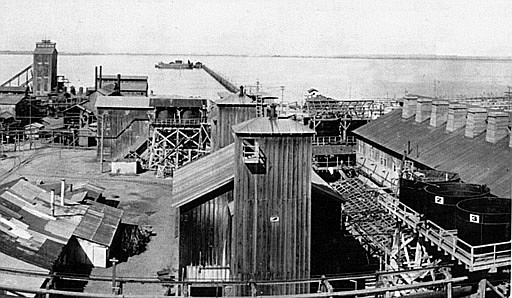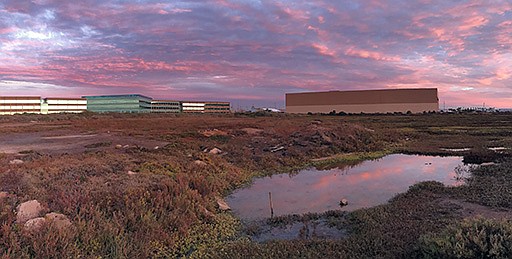 Facebook
Facebook
 X
X
 Instagram
Instagram
 TikTok
TikTok
 Youtube
Youtube

The U.S. Fish & Wildlife Service on Tuesday (December 5th) unveiled its plan to clean up three areas in the Sweetwater Marsh, bayfront land north and south of the boundary between National City and Chula Vista contaminated by gunpowder manufacturers, a dump, farmers, and a number of other uses that started in the 1800s.

Each of the areas has different contaminants, and Fish & Wildlife staff and contractors have extensively studied and sampled the areas before coming up with plans for each that include soil removal and groundwater management. The federal agency held public meetings to seek the community's comments on current plans to remediate the contaminated sites within the marsh and to get the word out on the plan's comment period, which ends December 15th.
The goal is to get to a clean soil base for restoration of the coastal wetlands whose contaminants do particular harm to migratory birds. Much of the proposed cleanup involves removing soil that's contaminated with lead, arsenic, cadmium, and other metals, perchlorate and dioxins, and old-school pesticides like DDT. The dangers of lead and arsenic are widely known; perchlorate easily dissolves in water and, in humans, is connected to thyroid disease including cancer.
The sites are part of the San Diego National Wildlife Refuge, home to endangered, threatened, and near-threatened species including the light-footed Ridgway's rail, western snowy plover, and California least terns, as well as salt-marsh bird's beak (a rare plant species). The good news is that most of the contamination is in the surface soil, and most of that was added on top as fill and hasn't contaminated the native soil beneath.
The feds estimate the total cost of the three cleanups at around $18 million. It will involve trucking about 70,000 cubic yards — about 3200 dump-truck loads — of contaminated soil from the sites. That the contaminants are mostly in the shallow topsoil is in keeping with the sites' histories, according to wildlife refuge project manager Andy Yuen.
Gunpowder Point has the most interesting history: it was once home to the world's largest gunpowder component plant and remains the site of Chula Vista's largest and longest burning fire, according to historical accounts.
During World War I, the leading producers of potash used in gunpowder — the Germans — stopped supplying the British with gunpowder. U.S. entrepreneurs jumped into production by building a plant that extracted gunpowder precursors, acetone and potash, from kelp. The Hercules Powder Company opened in 1916, with 1400 workers and a 1200-foot pier off the point to unload kelp harvested up the coast as far as Santa Barbara.
The plant produced more than 45 million pounds of cordite before it shut down in 1920. Within a few months, a company that squeezed oil from cotton-seed hulls took its place and operated on the point for a decade. San Diego Oil Products closed briefly in 1923 after burning down. The company rebuilt and reopened in months. Over time, a variety of kelp-harvesting businesses came and went as tracts of land became citrus groves.
By World War II, much of the land was leased for farming, including land leased to Japanese families who were held in U.S. internment camps during the war. The tomato greenhouse on the land was eventually featured in Attack of the Killer Tomatoes, filmed without the farmers' permission. The feds bought the land in 1988 as part of a lawsuit settlement to mitigate for constructing Interstate 5. Today, Gunpowder Point is empty of buildings and ripe for remediation.

Nearby, the cleanup of Paradise Marsh and part of Sweetwater Marsh is mainly about “burn ash.” The area north of the Sweetwater flood-control channel was once home to Davies Dump (1920s–1950), where people brought trash from National City, Chula Vista, and San Diego. What couldn't be reused or sold as scrap was burned, and the ash was plowed into the marsh, according to historical reports. The state bought land in 1949 for I-5, and the old Davies Dump was part of the purchase.
The third area slated for cleanup is the F & G street marshes, which were used as an authorized dump between 1964 and 1975 as roads and industries were built nearby. In one area, the soil and construction rubble dumped there showed levels of lead and chromium high enough to be classified as hazardous waste, according to consultant reports.


The U.S. Fish & Wildlife Service on Tuesday (December 5th) unveiled its plan to clean up three areas in the Sweetwater Marsh, bayfront land north and south of the boundary between National City and Chula Vista contaminated by gunpowder manufacturers, a dump, farmers, and a number of other uses that started in the 1800s.

Each of the areas has different contaminants, and Fish & Wildlife staff and contractors have extensively studied and sampled the areas before coming up with plans for each that include soil removal and groundwater management. The federal agency held public meetings to seek the community's comments on current plans to remediate the contaminated sites within the marsh and to get the word out on the plan's comment period, which ends December 15th.
The goal is to get to a clean soil base for restoration of the coastal wetlands whose contaminants do particular harm to migratory birds. Much of the proposed cleanup involves removing soil that's contaminated with lead, arsenic, cadmium, and other metals, perchlorate and dioxins, and old-school pesticides like DDT. The dangers of lead and arsenic are widely known; perchlorate easily dissolves in water and, in humans, is connected to thyroid disease including cancer.
The sites are part of the San Diego National Wildlife Refuge, home to endangered, threatened, and near-threatened species including the light-footed Ridgway's rail, western snowy plover, and California least terns, as well as salt-marsh bird's beak (a rare plant species). The good news is that most of the contamination is in the surface soil, and most of that was added on top as fill and hasn't contaminated the native soil beneath.
The feds estimate the total cost of the three cleanups at around $18 million. It will involve trucking about 70,000 cubic yards — about 3200 dump-truck loads — of contaminated soil from the sites. That the contaminants are mostly in the shallow topsoil is in keeping with the sites' histories, according to wildlife refuge project manager Andy Yuen.
Gunpowder Point has the most interesting history: it was once home to the world's largest gunpowder component plant and remains the site of Chula Vista's largest and longest burning fire, according to historical accounts.
During World War I, the leading producers of potash used in gunpowder — the Germans — stopped supplying the British with gunpowder. U.S. entrepreneurs jumped into production by building a plant that extracted gunpowder precursors, acetone and potash, from kelp. The Hercules Powder Company opened in 1916, with 1400 workers and a 1200-foot pier off the point to unload kelp harvested up the coast as far as Santa Barbara.
The plant produced more than 45 million pounds of cordite before it shut down in 1920. Within a few months, a company that squeezed oil from cotton-seed hulls took its place and operated on the point for a decade. San Diego Oil Products closed briefly in 1923 after burning down. The company rebuilt and reopened in months. Over time, a variety of kelp-harvesting businesses came and went as tracts of land became citrus groves.
By World War II, much of the land was leased for farming, including land leased to Japanese families who were held in U.S. internment camps during the war. The tomato greenhouse on the land was eventually featured in Attack of the Killer Tomatoes, filmed without the farmers' permission. The feds bought the land in 1988 as part of a lawsuit settlement to mitigate for constructing Interstate 5. Today, Gunpowder Point is empty of buildings and ripe for remediation.

Nearby, the cleanup of Paradise Marsh and part of Sweetwater Marsh is mainly about “burn ash.” The area north of the Sweetwater flood-control channel was once home to Davies Dump (1920s–1950), where people brought trash from National City, Chula Vista, and San Diego. What couldn't be reused or sold as scrap was burned, and the ash was plowed into the marsh, according to historical reports. The state bought land in 1949 for I-5, and the old Davies Dump was part of the purchase.
The third area slated for cleanup is the F & G street marshes, which were used as an authorized dump between 1964 and 1975 as roads and industries were built nearby. In one area, the soil and construction rubble dumped there showed levels of lead and chromium high enough to be classified as hazardous waste, according to consultant reports.
Comments